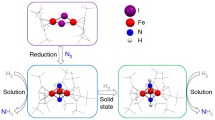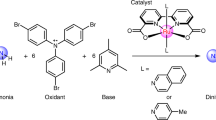Abstract
NITROGENASE, which contains iron, molybdenum and thiol groups, operates in an aqueous environment. Many attempts have been made to produce chemical models for nitrogenase based on the above knowledge and recently Schrauzer and co-workers have described dinitrogen-reducing systems of this type1,2 but they use high pressures of dinitrogen (135 atm) and obtain only 3 to 5 μmol. of ammonia from mmol quantities of reagents2 (see Table 1, example 1).
This is a preview of subscription content, access via your institution
Access options
Subscribe to this journal
Receive 51 print issues and online access
$199.00 per year
only $3.90 per issue
Buy this article
- Purchase on Springer Link
- Instant access to full article PDF
Prices may be subject to local taxes which are calculated during checkout
Similar content being viewed by others
References
Schrauzer, G. N., and Schlesinger, G., J. Amer. Chem. Soc., 92, 1808 (1970).
Schrauzer, G. N., Schlesinger, G., and Doemeny, P. A., J. Amer. Chem. Soc., 93, 1803 (1971).
Newton, W. E., Corbin, J. L., Schneider, P. W., and Bulen, W. A., J. Amer. Chem. Soc., 93, 268 (1971).
Shilov, A., Denisov, N., Efimov, O., Shuvalov, N., Shuvalova, N., and Shilova, A., Nature, 231, 460 (1971).
Author information
Authors and Affiliations
Rights and permissions
About this article
Cite this article
HILL, R., RICHARDS, R. Reduction of Dinitrogen in Aqueous Solution. Nature 233, 114–115 (1971). https://doi.org/10.1038/233114a0
Received:
Issue Date:
DOI: https://doi.org/10.1038/233114a0
Comments
By submitting a comment you agree to abide by our Terms and Community Guidelines. If you find something abusive or that does not comply with our terms or guidelines please flag it as inappropriate.



